Ask.com and Bing are very anxious to prove the world they can beat Google. Even in minor things, like Image Search that Bing was enhancing constantly over last several month. Or in a Search Engine Jeopardy contest, managed by Stephen Wolfram. Well, it seems Google competitors still have some work to do, as the Search Industry leader was victorious once again.
The SE Jeopardy consisted of Jeopardy questions randomly selected form a database of around 200000 that were fed into the search queries of various engines. The developers then looked at the number of correct answers that appeared in the search results page and also at the number of correct answers that were included in the page that search engines presented as the top result.
The results were as follows:
Percentage of correct answers appearing somewhere on the first page: Google – 69%; Ask.com – 68%, Bing – 63%, Yandex – 62%, Blekko – 58%, Wikipedia – 23%.
Percentage of correct answers appearing in the top result of the page: Google – 66%; Bing – 65%, Yandex – 58%, Ask.com – 51%, Blekko – 40%, Wikipedia – 29%.
Obviously Wikipedia didn’t stand too much chance, as it was only one website competing against “the whole internet”. Still, it must be noted that only about one-third of Jeopardy answers are already in Wikipedia…
As to Search Engines – Google has beaten the competition, although the margins are not that big. But based on these results, Ask and Blekko have to do a better job of listing the most relevant link at the top (see how their percentage dropped when they looked into the first document. And Bing is “almost there” – but still a fraction behind Google.
Yandex numbers were very impressive, as it is basically a local Russian search engine. If the test has been done in Russian (or at least, based on Russian Jeoprdy Analogue, “Svoya Igra”, which includes fewer questions about American culture and history) Yandex would probably beat Google – exactly as it does in the Russian Search Engine market.
In summary, nobody can beat Google in providing relevant information. Not just yet. So, when you want to know “What is” something – don’t ask and don’t bing. Google it!
With Google being the most popular search engine in the world, and particularly in the US, it is not yet gained enough ground in non-English speaking countries. While in India, the UK and Australia Google is the runaway leader in Search Engine competition, there are still countries in which local search engines are quite successful in opposing the G- giant. Baidu is number one in China (and there is also a new player in the SE field, supported by the government – goso.cn), and most former USSR-countries internet users (Russian speakers) prefer Yandex over Google.
Yet, Google is trying hard to get into the local markets. Recently, it has reported a successful takeover of the number one spot in Czech Republic, surpassing the local leader Seznam.cz in the first week of 2011.
Seznam, however, does not agree, stating that the statistics are not conclusive, and presents different figures, such as having almost 70% of Czech internet “population” with about 4 million users. Moreover, Seznam.cz emphasizes the misleading inaccuracy, as Google statement is based on report that takes into account both local and global pages, while Seznam only concentrates on Czech-based domains. They are also accusing Google of “refusing to participate in official measuring”.
Well, whether Google report is accurate or not is not very significant. The important fact is that Google puts an enormous amount of effort to increase the grasp of local, non-English-speaking markets.
It is widely known that Google has many local rivals in the Search Engine field. Many Russians prefer Yandex over Google, Israelis use Walla and in China there is Baidu. Most of those engines are extremely localized, providing relevant search results and successfully battling with Google in the local market – especially, since they use local language in countries with relatively low English level among computer and internet users.
Almost half-billion China-based internet users are a huge marketing potential. It seems, Chinese government has recognized it, deciding to launch a new search engine, which will be the first state-owned SE in the world. After over half a year of trial version (how do you say “beta” in Chinese?), goso.cn is now fully operational and available. The idea is to implement elements of social media into the engine – such as videos, photos and comments sharing. Mobile version is expected as well.
Of course, competing with Baidu and Google is not an easy task – but with the support of the government, goso can well become a healthy search engine alternative in few years time.
It’s no big news that Chinese market is growing with an impressive speed and more and more businesses turn eastwards – both for production and marketing. Over a billion people live inside the Far East giant borders – a healthy reason to address the region in order to increase sales as well as exposure.
The news is, however, that the internet content is now also part of the trend. China has reportedly surpassed USA in the number of internet users in mid-2009, and although English is still the primary internet language (42 percent of almost two billion of online “population” worldwide), Chinese is in solid second place, with about 32 percent. And since China is still less technologically advanced than the Western Countries, the number of potential Chinese speakers, who will soon be joining the online world is far greater than that of the English language carriers.
And with the Chinese government now requiring all English content in China-based websites to be accompanied with local Mandarin translation, the number of webpages in Chinese is about to increase immensely. And, restating the above thought about more and more companies regarding China as a prospective market, it seems that the near future of online marketing can easily shift toward Chinese content.
UK shopping market maybe smaller than the US one, but Google wants to make an impact on it as well, introducing Google Nearby Shops UK. Now, when you query for certain product via UK Google Product Search, you will have the shops selling it appearing map-style below your search, to help you locate the closest item to your location.
Of course, if you are a merchant and want to take advantage of this feature, becoming listed in those results, you need to have your shop’s URL linked to both Google Places and Google Merchant Center.
For both buyers and sellers, this combination of Google Maps and Google Products can be very useful in this Holiday season.
Google has recently announced that Google Instant Mobile is now available “globally”. This means that the tool is released for all countries that have Google Mobile access (there are several dozens of those) and supports almost thirty languages.
The product, similarly to Google Instant Mobile, is integrated into search features for any Android browser (built-in for Android OS 2.2 and up) , and features various algorithms that allow faster dynamic search results.
Although this release was expected (shortly after releasing Google Instant Mobile in English, the company had announced that international support is on its way) – nobody anticipated that this would happen so quickly. The roll-out took Google slightly over one month time – an incredible figure, considering the complexity of the product. Of course, this simply means that Google had been working on globalization of Google Instant Mobile simultaneously with the product itself. That is no wonder – Google had always emphasized the importance of international marketing and global support.
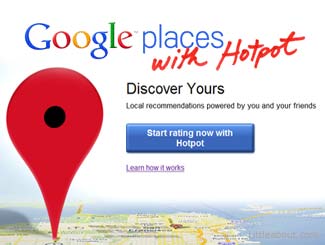 Think of it this way – As we travel through a new type of landscape we are guided by signs as always. But the source of the signs and information is much different. Travelers are creating the guidelines and providing directions for the inquiring traveler. This is what happens with Google Profile. Users rate/review businesses, restaurants and service providers based on their experience.
Think of it this way – As we travel through a new type of landscape we are guided by signs as always. But the source of the signs and information is much different. Travelers are creating the guidelines and providing directions for the inquiring traveler. This is what happens with Google Profile. Users rate/review businesses, restaurants and service providers based on their experience.
If you are in a neighborhood that is popular with you and your circle of friends you can use Hotpot to find restaurants, bookstores, business offices etc. that will include the locations that are popular with your friends.
Here’s the recipe:
Add an ingredient with a decidedly local flavor to an icon of the Internet world and what do you get? Google Hotpot, a new dish that is seemingly a combination of Places and Profiles. What does this new menu item do for us, the user?
It helps us find local destinations, like businesses and restaurants.
This creates a large database of information in Places, of course. But it also helps the Internet behemoth with another task – making suggestions to users in the future. Add the “friend” touch and you have a referral and suggested destination business model called Hotpot that guides you to physical locations in your area.
How it Looks
A quick look reveals an uncluttered, almost simplistic, design – just what you would expect from Google. Hey, it works!!
Sign in and start rating, that’s all there is to it.
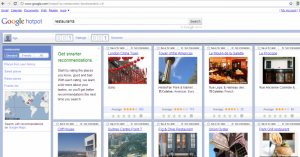
Obviously, you can do your rating and searching on your computer. But these actions are also available on the Android 1.6+ phone with the Google Maps 4.7 update.
At this point the emphasis is on good places to eat and drink – you know, restaurants and cafes. But Google Hotpot isn’t limited to consumption of food and beverages. Users can review any retail site, schools, libraries, even a nice park for a bit of quality time outdoors. A recent count by Google indicated that users have already placed millions of reviews on the service.
For example, one of the icons of Southern Illinois and the St. Louis Metro-East area is the Brooks Catsup bottle. This huge landmark is atop a tower in the town of Collinsville. Want to find this unusual site? It’s on Google Hotpot, complete with a color photograph and address.
Simply click on the number next to the average rating (five star system) and you can read the individual comments and reviews. Choose the business name – the live link at the top – and you are taken to a page with a map, address and review information. You may even get another photo.
Why Hotpot Now?
Most of the early reviews of Hotpot emphasize that this is a way for Google to take on such social sites as Facebook, Yelp and others. The focus is local. But there is supposed to be a significant difference with Hotpot. Reviews and information come only from people that are brought into your network.
The product manager for Google wrote, “With Hotpot, we’re making local search results for places on Google more personal, relevant and trustworthy.”
The idea is not particularly cutting-edge because there are several other ways to connect with friends and recommend places to spend time and money. For example, a user can select Yelp for the closest city and find all sorts of information about restaurants and other businesses.
But This is Google!
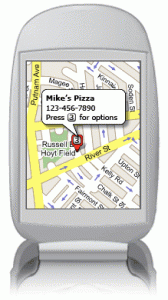 That will capture a lot of attention. Throw in the Android access and Google Hotpot is coming into this market at a time when the Internet and World Wide Web are about “apps,” not searching. We are gradually moving into an electronic world that won’t require much searching. Some say we are there already.
That will capture a lot of attention. Throw in the Android access and Google Hotpot is coming into this market at a time when the Internet and World Wide Web are about “apps,” not searching. We are gradually moving into an electronic world that won’t require much searching. Some say we are there already.
We mentioned the key word “local” a bit earlier but we should have mentioned another key word in this scenario – “social.”
Social networking is far from new. In fact, we could argue that the Internet and the Web have been “social” for years. But with Hotpot, the world’s fastest-growing company, Google, is making a statement – We are more social. We are more local.
As one Hotpot review stated, this is the way things work now.
The Google LatLong Blog says Hotpot makes about 50 million locations available, as indicated on Google Places. Users step into the process to share their recommendations with friends, based on individual tastes and interests. When the iPhone Places app comes online Hotpot will add thousands more mobile users.
If all of this doesn’t seem earth-shaking, consider the one ingredient Google has that even the other social platforms don’t have. It’s called “consumer reach,” according to http://venturebeat.com/
Does this mean that Yelp and Foursquare will gradually wither and die on the vine? Probably not, at least for the very near future. But it is possible that Google Hotpot could be the killer app when it comes to navigating the local scene.
On a technical basis, Hotpot is, for the most part, a free-standing service. But if Google and its users decide to do some serious “mashing” and combining, Google Hotpot might stand next to “GPS” as the way to find your way around.
The merging of services hasn’t happened yet. Users still have to work with Hotpot on its own turf. But this will probably change sooner rather than later.
Some veteran industry observers are less than enamored of Google Hotpot. It’s nothing new or particularly useful, they say. What will the world say?
Stay tuned.
Not too long ago, Wired magazine ran an article by Chris Anderson and Michael Wolff entitled “The Web is Dead, Long Live the Internet.” In the introduction to that article the authors write, “Two decades after its birth, the World Wide Web is in decline, as simpler, sleeker services – think apps – are less about the searching and more about the getting.”
If this is true, finding your way to the top of the search engines won’t be quite so crucial, in terms of business success. The authors note that people may spend their entire day on the Internet and never really search the Web. Specific apps for email, social sites, news and business resources make it unnecessary to type and search.
Anderson and Wolff urge the skeptics among us not to toss this off as “a trivial distinction.” They call the new model “semi-closed platforms” that use the Internet as a transportation device. But there is no basic need for a browser to display pages. The bottom line is it’s “a world Google can’t crawl.”
What does it mean to rank #1 on the major search engines in 2010 and beyond? Is it as important as being the “big dog” a few years ago? Or, as some believe, is it not quite as important as in the past?
Off to the Races?
 The year 2010 may be remembered as the period of time when use of the Web and Internet changed significantly. What change, you may well ask? It seems obvious that if the majority of people are starting to fine-tune their Web use to the point of using only a handful of specific apps, the key factor is going to be speed.
The year 2010 may be remembered as the period of time when use of the Web and Internet changed significantly. What change, you may well ask? It seems obvious that if the majority of people are starting to fine-tune their Web use to the point of using only a handful of specific apps, the key factor is going to be speed.
Several industry observers have started to focus on page-load speed as one of two or three major factors for Web site success. For example, professionals in this field are urging Web designers and administrators to offer thumbnails of images so that the visitor doesn’t have to wait for a full-size image to load. Give the viewer the option to select the larger image. It’s a simple step.
In keeping with this trend toward almost-instant gratification, Google has come forward to emphasize page speed as a key factor. After all, for Google to be successful millions of Web users around the world must continue to search. One of the primary “enemies” of the old search pattern is the mobile device.
As cell phones and other devices take on tasks formerly completed only on a powerful desk computer, the need to search will be in decline. Sites will be developed for mobile devices and for the specific applications that work best on the mobile device.
Take the Local
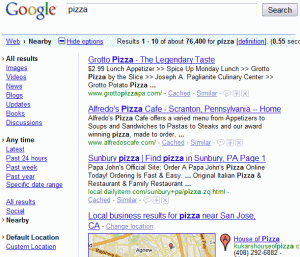 As we discuss this major change in Web use we should also consider this thing called the local search. In simple terms, being #1 worldwide will mean less if a viewer limits the search (and use) to fewer sites. For example, businesses of all types may start to limit their marketing to sectors such as Google Places or to Hotpot (interesting name). This last item is a ratings tool as well as a recommendation engine for Google Places. It’s designed to focus on local service, based on visits and recommendations from friends and other users.
As we discuss this major change in Web use we should also consider this thing called the local search. In simple terms, being #1 worldwide will mean less if a viewer limits the search (and use) to fewer sites. For example, businesses of all types may start to limit their marketing to sectors such as Google Places or to Hotpot (interesting name). This last item is a ratings tool as well as a recommendation engine for Google Places. It’s designed to focus on local service, based on visits and recommendations from friends and other users.
Will search-engine optimization maintain its place as a key to Web site success? The answer could be “yes” and “no” together. Relevant, reliable content that is useful on a consistent basis will still put sites near the top of the priority list. One good example for incorporating the speed idea into the mix is using WebP images that will load faster than bulky JPEGs.
Here are some reasons why we should start using WebP:
Perhaps one of the most important ideas Webmasters, developers and marketers can take from this discussion comes from Anderson and Wolff, authors of the Wired article. “The fact that it’s easier for companies to make money on these platforms only cements the trend. Producers and consumers agree: The Web is not the culmination of the digital revolution.”
A Few More Thoughts
Listing the key items for WebP use and including the emphasis on making money makes the argument for page speed quite strong. However, WebP won’t be an industry-wide standard immediately. Most people will continue to use JPEG or another popular format in the near future. But designers and administrators should give serious thought to using thumbnails to reduce load time.
As for the idea of making money on the Web, we might go back to the old real estate mantra “location, location, location.” Make sure your Web content is placed properly and the page-to-page connections are efficient. Add the local ingredient to your Web marketing to secure your place in a defined area.
Here’s a sobering thought for the doubters out there. The Wired article points out that a 1997 cover story in that magazine was already urging readers to “kiss your browser goodbye.” The emphasis for the future, according to this theory, was going to be on applications for specific purposes and a Web that was getting closer to “out of control.”
Walled gardens in which users were controlled by the provider certainly didn’t prove to be the success model. Google seemed to have “it!” But now it seems that even this game-changing business model wasn’t the final answer. Stay tuned.
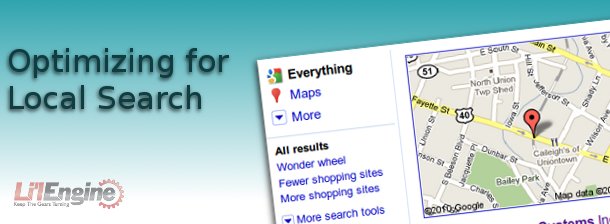
Local search engine listings may be little more than an afterthought to some webmasters, but they are a source of business that you shouldn’t ignore. Optimizing your site for local searches and making sure you’re listed in the local versions of the major search engines is a smart move, and doing so is fairly quick and easy. The three biggies in local search are Google Local, Yahoo! Local, and Bing Local.
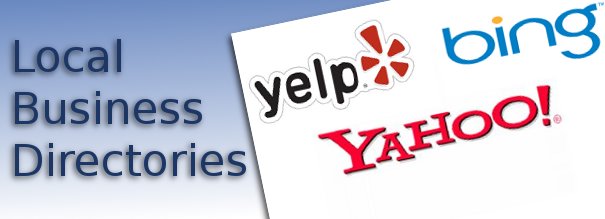
Local internet business directories can help your business out locally. While you may consider your business to be web-wide, there’s nothing wrong with getting the support of the local population, particularly if your business has a bricks and mortar presence too. Even if you do all your work over the web (such as translating documents or writing software apps), there’s no telling who might be living in the same area as you who needs exactly the skills your business offers. Don’t miss out on local attention thinking that just being on the web will catch everyone. It doesn’t take long to sign on to local business directories, and in most cases it’s free. Three local directories you should check out are Yelp, Yahoo! Local, and Bing Local.
Isn’t it a rush to get positive feedback about your business? Well, those compliments can be used to your advantage if you use them wisely. The goal is to not only get compliments, but also get real recommendations that other potential customers can see. That’s why local directories like Yelp are so helpful. yelp.com lets you gather good reviews about your company from customers. It is easy to get started.
First, register your business on Yelp by using its business profile directory. You can do this for free at https://biz.yelp.com/signup (see screen shot). The next thing to do – and this is important – is to review other companies and services you’ve used yourself, whether it’s a mechanic, a veterinarian, a restaurant, or some other local business. Keep your reviews positive, which means only reviewing businesses about which you feel positive. If you appear troll-like, you wont’ gain any credibility.
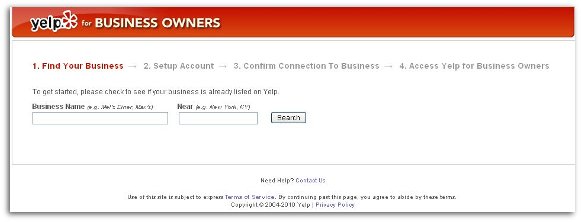
The next thing to do is to invite colleagues and friends to comment on and review your business. You don’t want a flood of these to come in at once. Yelp dislikes spam, and may construe a dozen glowing reviews your first day as such. Another thing you can do is ask your reviewers to review other local businesses as well so Yelp doesn’t think you’re coercing people.
You should build a good profile on Yelp, and you need to stay active in your community by reviewing other businesses (Many will reciprocate.) and make your listing more than just a boring list of your services and business hours. Let all your customers know that you’re on Yelp and that you’d appreciate a review. This is a good thing to include in your business’s email newsletter if you have one. The more you use Yelp’s social networking features, the wider a group of people you’ll connect with, boosting your presence on Yelp even more.
Claiming your Yahoo! Local profile will expose your business to local clients, and you can use the same information and photos that you use on Google Local (if you have it). You can edit your Yahoo! listing any time with changes to business contact information, business hours, and other important information. You can, if you choose, invest in a local enhanced listing. This lets you add to the basic listing your company logo / tagline, up to 10 photos, a more detailed business description, two customizable links for coupons, inclusion in up to 5 categories. You can check out the kind of things you get from an enhanced listing from the screen shot.
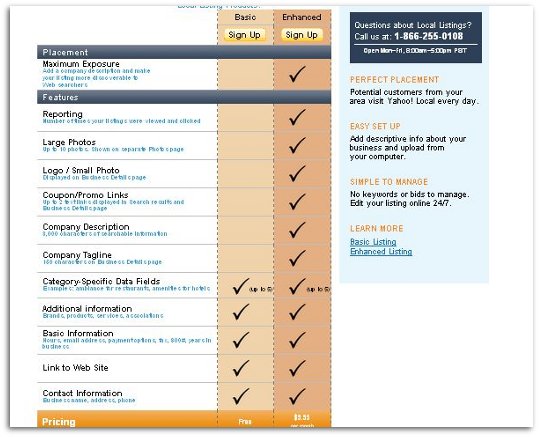
But even the free listing will bring more business your way. Yahoo! Local only lists businesses that serve designated geographic locations in the U.S., so if you’re online-only or statewide, then you can’t list there. You can improve your chances of your listing being accepted by carefully reading the basic listing requirements first and follow them. Assuming you are able to list there, ensure that the name of your business and your contact information is shown on every page of your website. If you don’t have a bricks and mortar store, clearly show how potential customers can make an appointment with you. Keep in mind that it may take up to five ddays for your listing to show up on Yahoo! Local, so don’t resubmit your site if it hasn’t been at least five days. You can check on the status of your listing on the Yahoo! Local Listings website.
Setting up your local listing on Bing is easy and it’s free. The first thing to do is to go to the Bing Local Listing Center, where you can create a local listing. When you start creating your account, Bing asks you for your Windows ID. If you don’t have one, you’ll have to create one, or you can create one by going to this link before setting up your listing on Bing. You’ll have to enter contact and business info, additional phone numbers, email addresses, hours, etc. You’ll also get to fill out a long section for information like your company’s tagline, brands, affiliations, and a bunch of other things. Try to fill in as many fields as possible, because it’s to your benefit.
You can then choose up to six categories in which to place your business based on your associated keywords. Bing has good local search refinement, so you want to take advantage of this by choosing as many categories as you can. After you finish this, you’ll have to review your business listing and check that the push pin locator is correct. If so, submit it and you’re done.
You might think that these local directories don’t make much of a difference, but you’d be surprised. Having complete listings on all the local search providers is good for your business and gives your local customers (and potential customers) another way to find you. Setting up accounts on Yelp, Yahoo! Local, and Bing Local does not take very long at all, and it’s a great way to point more people toward your business.